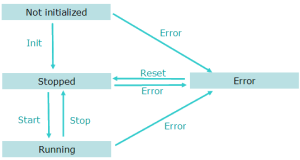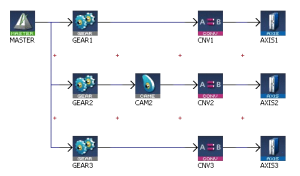Initialize and Start a Pipe Network
The Motion State Machine is driven by the IEC![]() "International Electrotechnical Commission"
IEC is a not-for-profit, non-governmental international standards organization that prepares and publishes International Standards for all electrical, electronic and related technologies 61131-3 application with the help of dedicated function blocks.
"International Electrotechnical Commission"
IEC is a not-for-profit, non-governmental international standards organization that prepares and publishes International Standards for all electrical, electronic and related technologies 61131-3 application with the help of dedicated function blocks.
Figure 4-15: Motion State Machine
Each arrow represents a transition from one State to another one.
To start a Pipe Network in an IEC 61131-3 application program, these steps must be performed with their respective functions:
|
Step |
Description |
|
|---|---|---|
|
||
|
2. Create Cam Profiles |
Profiles |
Create Cam Profiles from cam files. |
|
3. Create Pipe Network |
Pipe Network |
|
|
||
|
5. Power on all axes |
Pipe Network |
|
|
6. Activate the pipes |
Pipe Network |
|
|
7. Connect the axes to the pipes |
Pipe Network |
Example: In this Pipe Network, the function connects the Converter blocks (CNV1, CNV2 and CNV3) to the Axis blocks: |
See Motion / Common - Motion for more information about all ML function blocks related to motion








